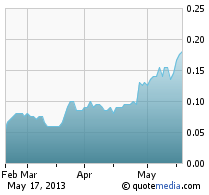
TSX:Â PP.VÂ |Â FSE:Â P9P| OCTQX:Â PPOTF
Pacific Potash has acquired a 100% interest in the Amazonas Basin Potash project in Brazil. The Company is planning a late summer exploration program on its claim block which totals 795,824 hectares. The Amazonas Potash Basin is similar in size, scale and geology to Saskatchewan’s potash evaporate deposit, which is the largest and most prolific potash reserve in the world.
3 Month Chart
Investment Highlights – Brazil
Amazonas Potash Basin
- The Brazilian Government plans to reduce Brazil’s reliance on potash imports from 91% to 60% over the next 5 years
- Soils in Brazil are deficient in potassium and require potash to remain productive
- The Amazonas potash basin is similar in geology and dimension to the Saskatchewan potash basin in Canada
- Two deposits owned by Petrobras—Arari and Fazendinha—are located 20 and 40 km west of the property being optioned by Pacific Potash. These two deposits have reported historic resources as follows*:
Fazendinha – 520 Mt @ 28.8% KCl
Arari – 659 Mt @ 17.7% KCl
Highlights of 43-101 Report
- Potash has been intersected on 3 margins immediately adjacent to the property (West, North, and North East).
- The Property is located on the northwest limb of the Middle Amazonas Basin, extending across the deepest part of the basin axis. The known occurrence of potassium salts (potash) is in Cycle VII in the Nova Olinda Formation. The Cycle VII potash mineralization occurs in numerous drill holes in the Middle and Lower Amazon basin, including those that define the Fazendinha and Arari potash occurrences.
- Well log control from within the basin, but outside the claims, indicates thickening of the Nova Olinda formation towards the basin axis.
- Potential potash layers are expected to occur at depths of 1100 to 1800 m.
Highlights of the Agapito & Associates Report
- Potash mineralization at the Fazendinha and Ararà properties was identified by Petrobrás in the 1970s and 1980s. Grades reported at Fazendinha range from 28% to 33% potassium chloride (KCl) over thicknesses ranging from 0.98 m to 4.58 m. The depth of the potash zone ranges from 1,000 to 1,100 m. At Ararà the depth to the potash zone ranges from 995 to 1,300 m.
- Brazil Potash Corporation’s drilling near Autazes, west of the Company’s claims, has encountered potash in 13 wells. Potash grades ranged from 15% to 40% KCl, over thicknesses ranging from 1.35 m to 3.13 m. Two wells near Itapiranga, north of the Company’s claims, encountered potash, with grades of 23% KCl over 2.20 m and 26% KCl over 4.84 m, respectively.
- The ambient temperature at these depths could range from 41 degrees Celsius (°C) to 51 °C based on average crustal heat flows and the local geology. This temperature range is comparable to the temperature encountered at the Belle Plaine solution mine in Saskatchewan.
- Based on the above, the Agapito report concludes that solution mining on the Company’s permits is potentially feasible if potash is encountered during exploration drilling, provided that the true thickness of the potash bed(s) exceeds 2 m, and the grade of the potash exceeds 15% K2O (24% KCl). Solution mining of KCl is enhanced if the ambient formation temperature in the potash beds exceeds 40°C.
Hub on AGORACOM / Corporate Website
Tags: #mining, #smallcapstocks, $TSXV, agriculture
